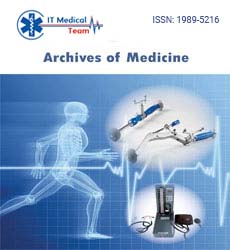Perspective - (2022) Volume 14, Issue 5
Factors that affect left ventricular mechanical dispersion in aortic stenosis and their implications for prognosis
Mark Victoria*
1Department of Cardiovascular Medicine, San Francisco, San Francisco, California, USA
*Correspondence:
Mark Victoria, Department of Cardiovascular Medicine, San Francisco, San Francisco, California,
USA,
Email:
Received: 25-Apr-2022, Manuscript No. ipaom-22-12845;
Editor assigned: 28-Apr-2022, Pre QC No. P-12845;
Reviewed: 17-May-2022, QC No. Q-12845;
Revised: 22-May-2022, Manuscript No. R-12845;
Published:
27-May-2022
Abstract
Calcific aortic stenosis (AS) is one of the most prevalent valvular heart diseases in the Western world.The increased afterload imposed by the narrow aortic valve area on the left ventricle induces a remodelling process, which is initially characterized by adaptive left ventricular (LV) hypertrophy. Long-standing AS further induces myocardial fibrosis, heart failure, and poor outcome. Therefore, alongside presence of symptoms and severity of AS, timely assessment of LV systolic dysfunction plays a pivotal role in the decision for referral to aortic valve replacement (AVR).
Keywords
Anxiety; Psychiatric; Stenosis
Introduction
Left ventricular ejection fraction (LVEF) is the benchmark parameter to define LV systolic function and is included in current guideline recommendations However, LVEF may not recover after AVR and patients may remain symptomatic. Speckle tracking echocardiographic parameters of LV shortening and mechanical dispersion have been proposed to detect LV systolic dysfunction at an earlier stage than LVEF and are related to the presence of myocardial fibrosis on cardiac magnetic resonance [1-4].
About the Study
The increase in myocardial fibrosis may lead to slow conduction and heterogeneous activation of the left ventricle which can be quantified by measuring the LV mechanical dispersion on speckle tracking echocardiography. Prolonged LV mechanical dispersion has been associated with worse outcome in various cardiomyopathies, after myocardial infarction and (as shown more recently) in patients with severe AS. However, the underlying mechanisms and relationship between LV mechanical dispersion, LV hypertrophy and QRS duration in various grades of AS are currently lacking. We hypothesize that LV mechanical dispersion increases with the severity of AS and may impact outcome [5].
Conclusion
Clinical parameters along with scientific history, cardiovascular threat factors, cardiac symptoms, and bodily exam had been accrued from sufferers’ scientific records. The first two-dimensional (2D) transthoracic echocardiography displaying analysis of AS become taken into consideration the baseline reference and the resting 12-lead electrocardiogram (ECG) acquired for the time being of the baseline echocardiography become evaluated. Patients had been observed for the incidence of AVR and all-reason mortality. Data entered with inside the departmental Cardiology Information System (EPD-Vision; Leiden University Medical Centre, Leiden, the Netherlands) become retrospectively accrued and analyzed. The institutional moral committee authorized this retrospective evaluation of clinically obtained records and waived the want for affected person written knowledgeable consent.
Conflicts of Interest
The authors declare no competing interests.
All authors declare that the material has not been published elsewhere, or has not been submitted to another publisher.
Data Availability
Authors declare that all related data are available concerning researchers by the corresponding author's email.
Acknowledgments
The views presented in this paper are of the authors and not of the organizations they represent.
REFERENCES
- Gordon EM, Figueroa DM, Barochia AV, et al. High-density lipoproteins and apolipoprotein AI: potential new players in the prevention and treatment of lung disease. Front Pharmacol. 2016 21;7:323.
Google Scholar, Crossref, Indexed at
- Coppens M,Wang D, Li R, Wang J, et al. Correlation analysis between disease severity and clinical and biochemical characteristics of 143 cases of COVID-19 in Wuhan, China: a descriptive study. BMC Infect Dis. 2020;20:1-9.
Google Scholar, Crossref, Indexed at
- Imazio M, Klingel K, Kindermann I, et al. COVID-19 pandemic and troponin: Indirect myocardial injury, myocardial inflammation or myocarditis?. Heart. 2020;106:1127-1131.
Google Scholar, Crossref, Indexed at
- Rackson ME, Mossey RT, et al. Nondilated obstructive uropathy: Percutaneous nephrostomy performed to reverse renal failure. Radiol. 1986;160:653-657.
Google Scholar, Crossref, Indexed at
- Bao J, Li C, Zhang K, et al. Comparative analysis of laboratory indexes of severe and non-severe patients infected with COVID-19. Clinica Chimica Acta. 2020;509:180-194.
Google Scholar, Crossref, Indexed at






